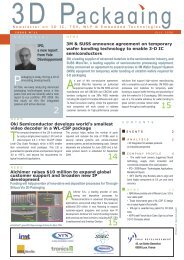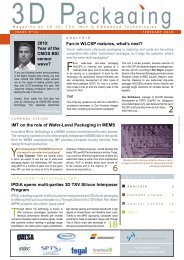September 2011 - I-Micronews
September 2011 - I-Micronews
September 2011 - I-Micronews
You also want an ePaper? Increase the reach of your titles
YUMPU automatically turns print PDFs into web optimized ePapers that Google loves.
S E P T E M B E R 2 0 1 1 I S S U E N ° 1 3<br />
HCPV supply chain - Positioning of the HCPV players: three scenarios<br />
(Yole Développement, <strong>2011</strong>, HCPV report)<br />
“HCPV systems<br />
makers are largely<br />
outsourcing<br />
production of their<br />
custom component<br />
designs to<br />
optics makers,<br />
tracker makers<br />
and electronics<br />
contract<br />
assemblers,”<br />
says Milan Rosina,<br />
Yole Développement<br />
are largely outsourcing production of their custom<br />
component designs to optics makers, tracker makers<br />
and electronics contract assemblers. But it is difficult<br />
for the system makers to best optimize the system<br />
cost and performance without knowing exactly how<br />
design choices will impact manufacturing costs at<br />
the supplier, or how one component can best be<br />
optimized to work with another component made<br />
by someone else. Optimizing the system requires<br />
careful balancing of all the parts, trading off more<br />
complicated and expensive optical systems for less<br />
accurate trackers or vice versa, or adjusting the<br />
characteristics of the primary optic to those of the<br />
secondary optic, and that’s hard to do by separate<br />
players.<br />
The fragmented sector is equally a problem from the<br />
supplier side. Suppliers argue that the components<br />
could be better designed for efficient low cost<br />
manufacture if the designer knew something about<br />
the manufacturing process, and that components<br />
could be better optimized to work together if they<br />
were designed together. Tracker makers complain<br />
that they have no visibility into if the market is big<br />
enough to support development of custom trackers<br />
for modules of entirely different size, weight, and need<br />
for accuracy. Designing custom components for each<br />
separate system maker’s kilowatt-scale projects is a<br />
very low volume business, with volumes sometimes<br />
only in the hundreds of units, often too small a<br />
business to be of much interest for the supplier, and<br />
too small for efficient volume production.<br />
Much depends on the successful performance of the<br />
early megawatt-scale HCPV projects now coming<br />
on line to build credibility for the technology. But<br />
building the first larger 10s and 100s of megawattscale<br />
installations will also require business<br />
models that enable optimized system design and<br />
foster a viable supply chain to support volume<br />
manufacturing.<br />
www.yole.fr<br />
Milan Rosina is analyst at Yole Développement for<br />
photovoltaic market & technologies. He received<br />
his Ph. D. in 2002 from the INPG in France. He<br />
gained experience as a research scientist in several<br />
renowned R&D institutions & industrial companies<br />
where he worked in the field of microelectronics, PV,<br />
LED & nanotechnology.<br />
18 P V M a n u f a c t u r i n g
















